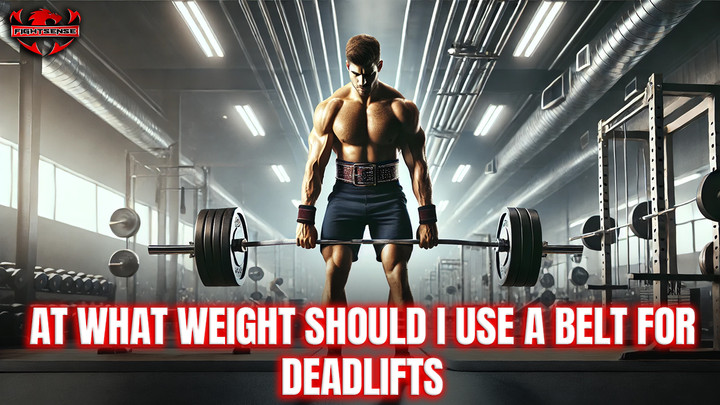At What Weight Should I Use a Belt for Deadlifts?
24th Mar 2025
This article will talk about at what weight should I use a belt for deadlift, taking into account things like your level of experience and your goals. Beginners usually start using a belt when they can lift 1.5 to 2 times their body weight. Advanced lifters may benefit from using one when they can lift 80–85% of their one-rep max to improve core support.
A lifting belt raises the pressure inside the abdomen, which makes the spine more stable and lowers the chance of damage when lifting heavy things. But you shouldn't depend on it too soon, because it can make it harder to learn how to brace your core properly.
Key Highlights:
-
When your core stability is low or you're lifting more over 80% of your 1RM, wear a belt.
-
A belt helps you deadlift better by making you more stable and lowering your risk of injury.
-
It helps the lower back and makes the pressure inside the abdomen higher, which makes lifts safer.
-
Sometimes doing out without a belt helps build natural core strength.
-
Make sure that your belt is in the right place, that it is tight, and that you are breathing correctly for the best benefits.
At What Weight Should I Use a Belt for Deadlifts?
There is no strict weight threshold for using a belt. Instead, it depends on personal lifting experience and strength levels. However, general recommendations suggest
-
Beginners (Deadlifting Less Than 1.5x Bodyweight): No belt is necessary. Focus on developing proper technique and core strength.
-
Intermediate Lifters (1.5x to 2.5x Bodyweight): A belt can be beneficial for heavy sets (80%+ of max lift).
-
Advanced Lifters (2.5x+ Bodyweight): A belt plays a significant role in maximizing strength and reducing injury risk.
A common benchmark is using a belt when lifting 80% or more of your one-rep max (1RM). If your core struggles to maintain tension or you experience excessive lower back strain, it might be time to consider a belt.
Why Do Lifters Use a Belt for Deadlifts?
Lifters often wear a belt during deadlifts to improve both performance and safety. A lifting belt provides several benefits:
-
Intra-Abdominal Pressure (IAP): Increases core pressure, stabilizing the spine and reducing the risk of injury.
-
Lumbar Support: Helps maintain a neutral spine position, mitigating strain on the lower back during heavy lifts.
-
Injury Prevention: While a belt can’t compensate for poor form, it provides vital support, lowering the risk of strains or herniated discs.
-
Force Optimization: Enhanced core stability enables greater force production, allowing for more efficient and heavier lifts.
-
Gym Enthusiasts & Athletes: Gym-goers and athletes often rely on high-quality lifting belts and deadlifting belts, such as those from FightSense, to maximize performance and prevent injury during intense training or competitions.
How Does a Belt Help Deadlift Performance?
A lifting belt enhances deadlift performance by optimizing biomechanics. Here’s how:
-
Enhances Core Engagement: Contrary to the myth that belts weaken the core, they actually help you brace more effectively.
-
Improves Lift Mechanics: Reduces energy loss by stabilizing the torso, allowing better form and efficiency.
-
Maintains Spinal Integrity: Prevents rounding of the lower back, a common cause of deadlift injuries.
-
Boosts Confidence: Many lifters feel more secure with a belt, helping them push through heavier lifts.
Should You Always Deadlift with a Belt On?
Not necessarily. While lifting belts can provide significant advantages, excessive reliance on them can hinder long-term progress. Below is a breakdown of when to utilize a belt and when to forgo it:
Wear a Belt When:
-
Lifting 80%+ of your 1RM, as the load demands enhanced core stability for proper execution.
-
Performing low-rep, high-intensity sets (3-5 reps) where maximal force production is required for optimal performance.
-
Training for maximum strength or competing in powerlifting, where additional support can prevent form breakdown under heavy loads.
Avoid a Belt When:
-
Lifting sub-maximal loads (below 80% of 1RM), where core engagement is sufficient to support the lift.
-
Focusing on core development, as a belt can mask the engagement of stabilizing muscles.
-
Performing high-rep endurance sets (10+ reps), where fluid movement and flexibility take precedence.
-
Learning or refining the deadlift technique, as the belt may impede your ability to identify and correct form discrepancies.
How to Deadlift Correctly Using a Belt
If you decide to wear a belt, using it correctly is crucial. Follow these steps:
-
Position It Correctly: The belt should sit over your lower abdomen, just above the hip bones.
-
Tighten It Properly: It should be snug but not overly tight—you should still be able to take a deep breath.
-
Engage Your Core: Before lifting, inhale deeply and brace your abs against the belt.
-
Maintain Proper Form: A belt is a tool, not a substitute for good technique.
Shop Now !
Conclusion
It depends on your strength and goals when you should use a belt for deadlifts. A belt is a great way to support and keep you safe when you lift more than 80% of your 1RM.
But don't count on it too soon; instead, work on your core strength and technique. FightSense makes high-quality belts that improve performance and keep you safe. Use it wisely to lift heavier and smarter.

